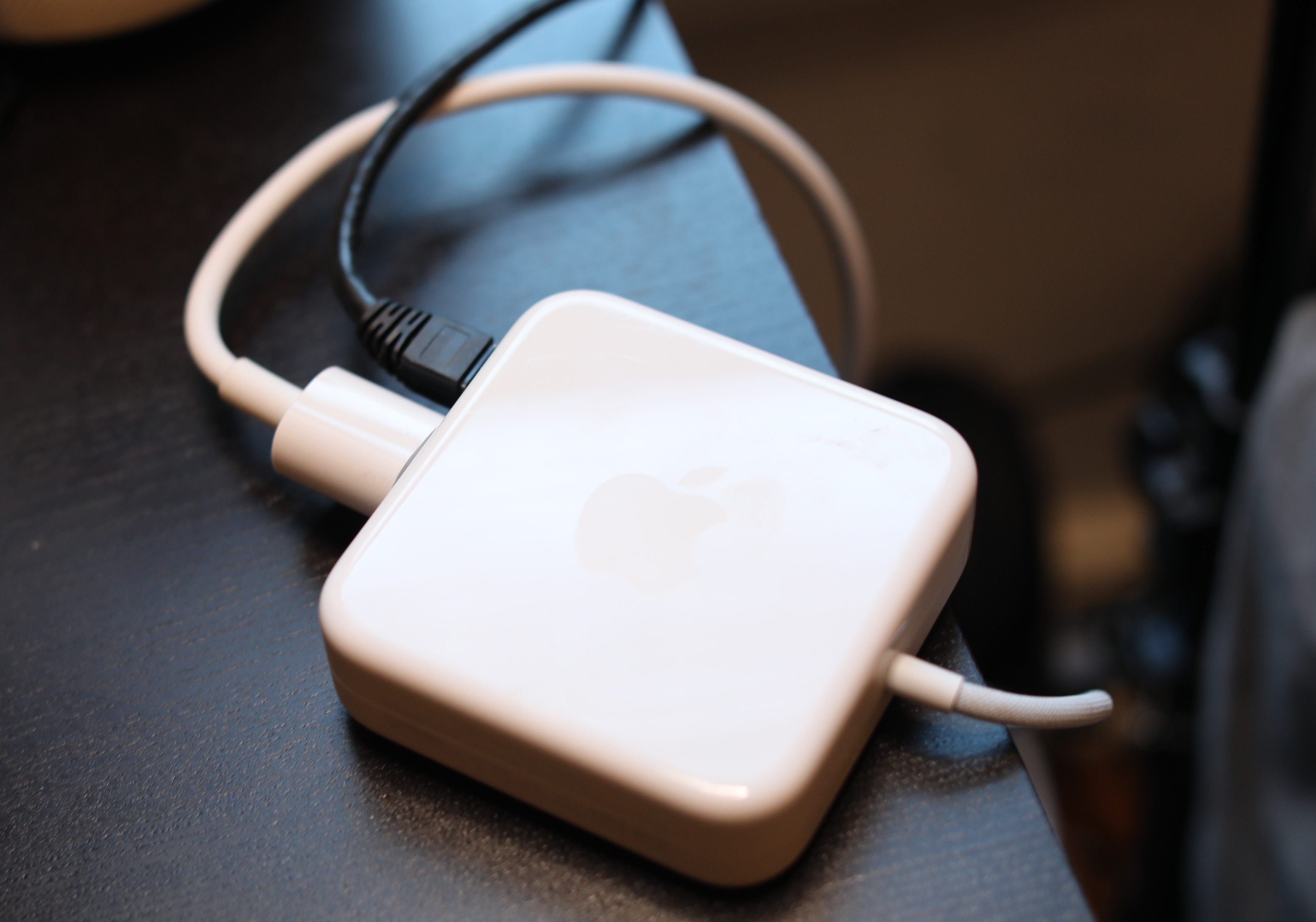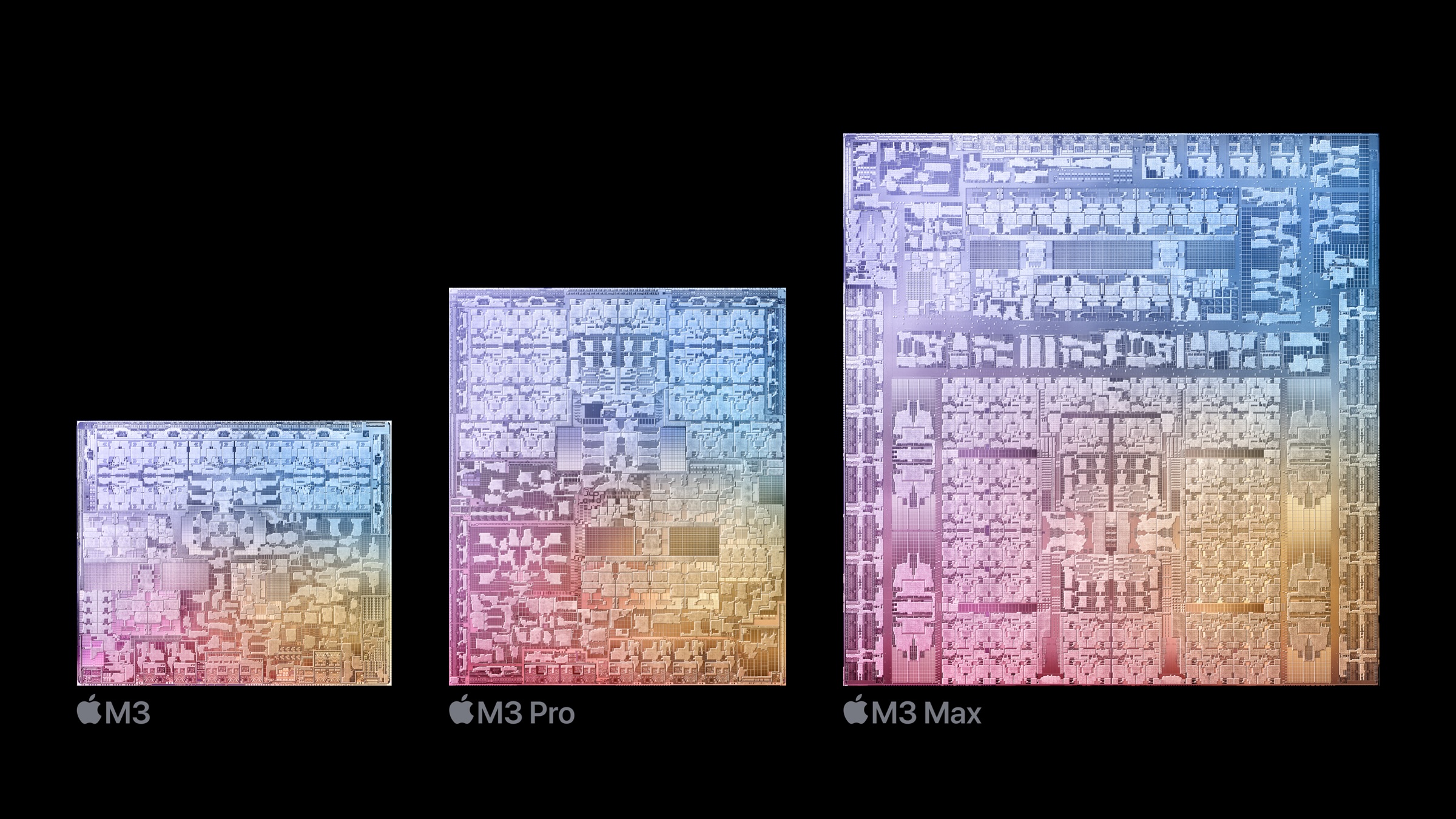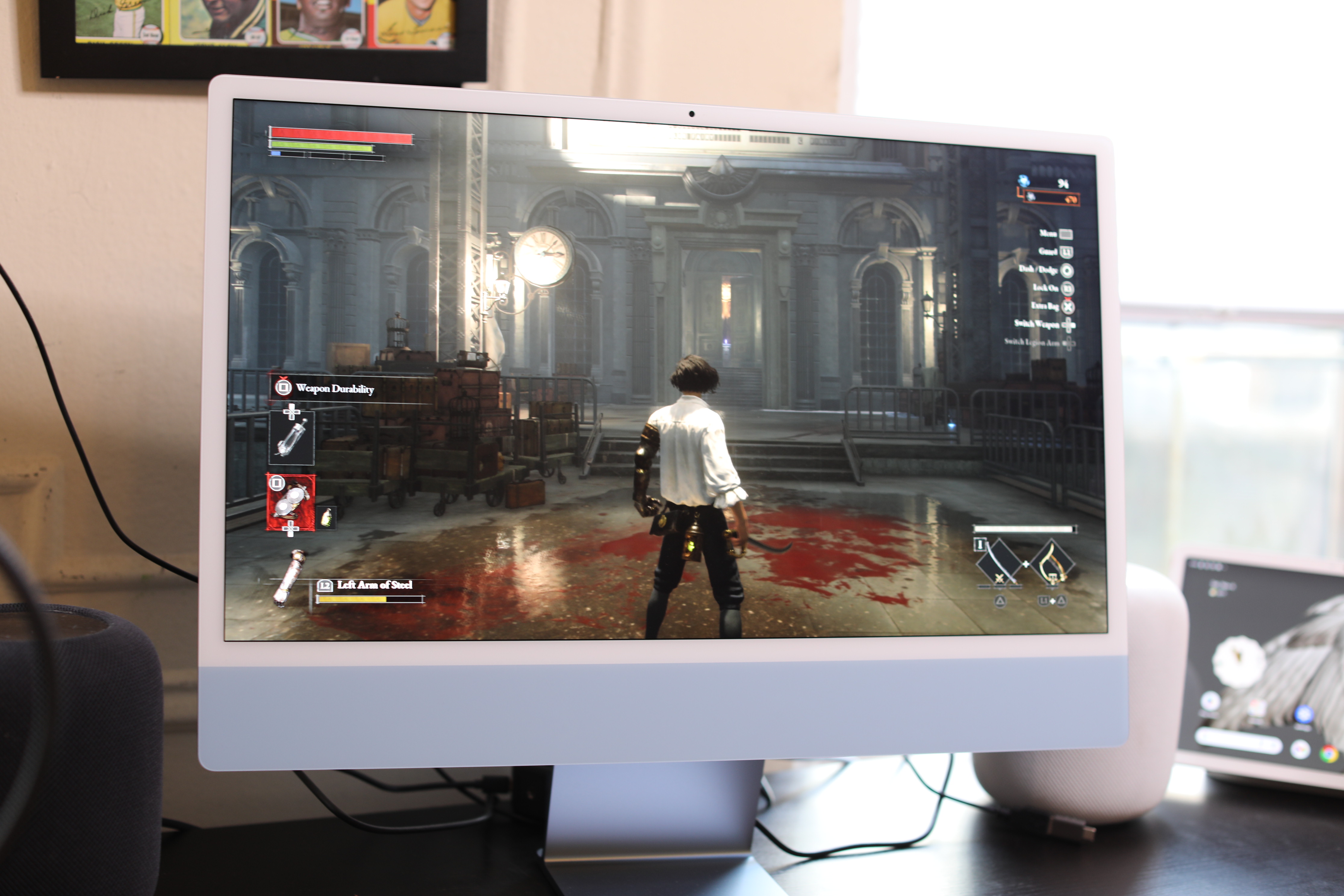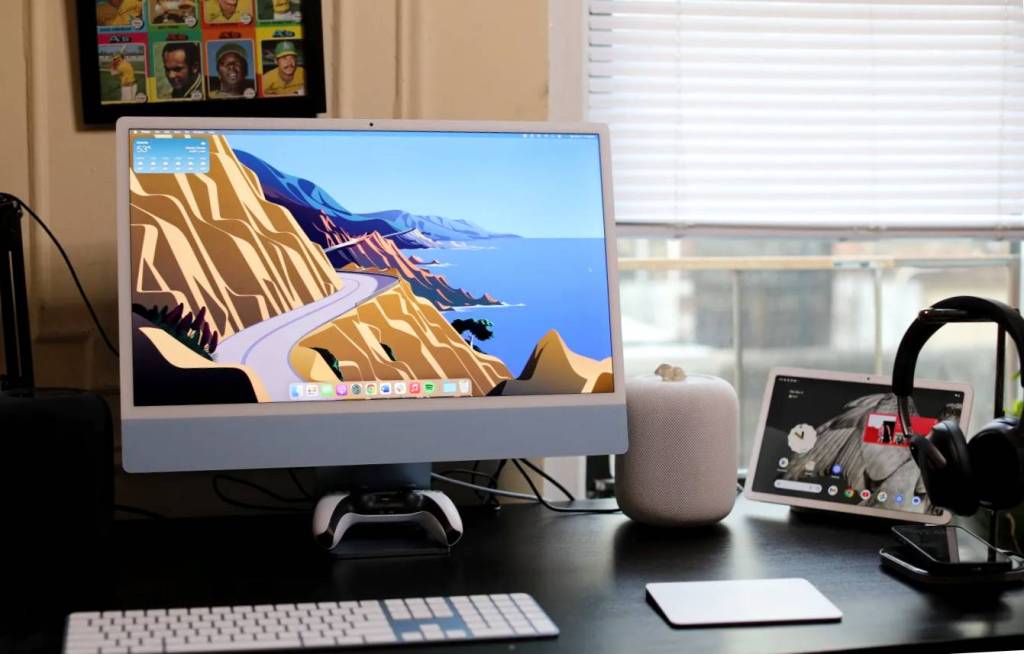A fun knock-on effect of this job is having to constantly switch between machines. The best way to test a product is integrating it into your daily routine as much as possible. This time out, that meant replacing the Mac Studio and 27-inch Studio Display with the new 24-inch iMac. It’s been an important reminder of why so many people go in for all-in-ones in the first place: I suddenly have a lot more space on my desk than I did an hour ago. Above all, Apple’s perennial favorite compact desktop is a lesson in not taking up too much space.
Back in 2021, the iMac saw its biggest update in years. Along with the M1 chip, the system got a complete design overhaul. There isn’t an exact comparison, given that the last of the Intel-based iMacs were available in 21.5- or 27-inch models, but the company did a nice job shrinking the footprint. For example, 2021’s 24-inch model is thinner (5.8 inches) than 2020’s 21.5-inch (6.9 inches). It’s lighter, too, at 9.8 pounds to the 21.5’s 12.1.
Design

Nothing has changed as far as footprint. It’s the same little iMac we got in 2021, available in the same color options as before: blue, green, red, silver, yellow, orange and purple. Apple sent the blue model this time out, which I have to say is an improvement over the yellow I got last time. It’s a light powder blue on the bezel. The metal stand and keyboard both carry a subtle blue hue, while the rear is much deeper. It’s cute. There’s no other word, for it, really. Just cute.
Apple recently told TechCrunch that it has no plans to release a 27-inch version, despite rumors to the contrary. Apple’s stance on the issue essentially boils down to: If you want something compact, the 24-inch has you covered. If you want something bigger and more powerful, take a good look at the Mac Studio with the 27-inch Studio Display.
Apple 16-inch M3 Max MacBook Pro review: A desktop among laptops
The company is also positioning the 24-inch iMac as splitting the difference between the 21.5- and 27-inch Intel models. The 4.5K Retina display (4480 x 2520 at 218 ppi) also quite literally splits the difference between the Intel models 4 and 5K options. Like the case, the screen is the same as what you’ll find on the 2021 models. That includes a peak brightness of 500 nits, across the board.

Likewise, the speaker and mic array are unchanged here. That’s six-speakers and three mics (the same number of both are found on the new MacBook Pros, as well). The speakers also sport force-cancelling woofers. That’s effectively a pair of woofers firing in opposite directions to cancel out bass vibrations that would otherwise shake the system — though you still feel some vibration on your desk with a particularly low-end song. The entire speaker system fires through a grille underneath the bottom bezel. That down-firing sound is then reflected off the desk surface.
The sound system gets the job done. I’m probably a bit biased on the subject at the moment, as I was previously listening to music on a stereo pair of HomePods. The iMac sound feels downright small by comparison. It’s perfectly fine for light music listening, video watching and gaming but if you plan to do a lot of any of the above, I would highly recommend picking up a pair of external speakers.

Around the back of the system, you’ll find two USB-C (USB 4.0)/Thunderbolt 4 (40 Gbps) ports on the $1,299 model. Pay another $200 and you’ll get a pair of USB 3 (4.8 Gbps) ports on top of that. That, along with additional color options, are the primary physical distinctions between the systems. The two-port version only comes in blue, green, pink and silver. The higher-end model also includes the clever power brick with a built-in gigabit ethernet port. If you end up getting the two-port system, but still need that wired ethernet, it’s an extra $30 at checkout. I tend to keep my router and modem on the floor, so I appreciate the setup.
The same goes for Touch ID. It’s the default on the four-port model, but another $50 tacked on at checkout will add it to your keyboard with the two-port. Or, if you spend $80, you’ll get a keyboard with Touch ID and the number pad. Both systems ship with a mouse by default. You can get the trackpad for an extra $50 or bundle the two together for an added $129. By default, both models come with the standard M3 with an 8-core CPU and 8-core GPU, plus 8GB of memory and 256GB of storage.

Apple sent the four-port model for review. It includes an 8-core CPU, 10-core GPU, 24GB of memory and 1TB of storage, the trackpad/mouse combo pack and a numeric keypad. Priced as configured, it’s going to run you $2,458. If you want to really go all out and double the storage to 2TB, the whole thing will set you back $2,858. That’s 2x the price of the entry-level two-port system, plus a couple hundred. Just like at the supermarket, the checkout is where they get you.
However, two ports isn’t enough for my taste. Like I’ve said before, it’s hard to argue with more ports. As it stands right now, they’re entirely occupied. Having a bit more spread out would also be great. One USB-A would be nice for older devices, and an SD card would add a lot for creative (though I suspect Apple would point you toward the Mac Studio in that case). Personally, I would point you in direction of a dock like this clever one from Satechi.
It adds one 10 Gbps USB-C data port, a 10 Gbps USB-A data port, 2 x USB-A 2.0 ports and an SD reader. More USB-C ports would be great, since you kind of break even as the dock needs to be plugged into one on the rear. There’s a whole micro-industry of adaptors that bring more ports to Macs. You should be able to find one that suits you. Among other things, I appreciate the industrial design on the USB-C Slim Dock and the fact that it effectively creates a little shelf where you can store your keyboard when you’re not using it.

As for the keyboard, well, I’ve got a dirty secret here. I swapped it out for my own mechanical model very quickly. I used the Magic Keyboard for years, but now that I’ve gone mechanical, there’s no looking back.
Apple’s keys don’t have much travel and there’s no support for standing it at an angle — though, again, you can also buy a third-party tilt stand, if that’s the route you want to go here. You do you. The one thing I absolutely miss, however, is Touch ID. It’s an extremely handy feature. Face ID would be a great option for the iMac, but Apple has no plans to add it as far as I’m aware.
There’s one other thing to address with the keyboard. Lightning. Apple’s desktop accessories are one of the few remaining vestiges of a connector that’s past its prime. It largely won’t bother you. There’s less daily wear, as most people don’t plug and unplug their keyboards and trackpads at the same rate they do their phones. Also, you’re probably not going to get pocket lint jammed in there. Still, it’s time for to Apple rip off the Band-Aid off, once and for all.
Camera

As is the case with the MacBook, the new iMac inherits the camera hardware from the previous generation (2021). Of course, that was released right as Apple was upping its webcam game with the long-awaited jump from 720p to 1080p. Rather than updating the sensor here, Apple is leaning on the M3’s digital signal processing power to make image adjustments. The result is a clear picture that’s enhanced a good deal by the addition of a pair of iPhone tricks: Studio Lighting and Portrait Mode.

Bottom: Insta360’s Link webcam
The former highlights the subject’s face, while making the background darker. The latter creates a digital bokeh effect around the user, to create the appearance of a shallow depth of field. Both features have sliders, so you can customize the levels. I find that they really do enhance the image, though I would love an option for an even more subtle background blur, partially because the feature can struggle with some edge. The gap between my head and the band on my over-ear headphones always gives it trouble.
If you’re exclusively using the camera for (name your teleconferencing software of choice) calls, it’s absolutely up for the task. As someone who does panels and livestreams, however, I prefer an external webcam, like the Insta360 Link I’ve been using for a while.

Bottom: FaceTime Camera with Studio Lighting and Portrait (turned all the way down)
M3

The M3 line is the first of Apple’s desktop chips to be created using TSMC’s 3nm process, following the iPhone 15 Pro’s lead. Apple has employed the 5nm process since the 2020’s M1 introduction. The new process brings performance gains with less power consumption, and the iMac is the first desktop with the technology.
There will be no 27-inch iMac, and the 24-inch is only available with the base-level M3, while both the new 14- and 16-inch MacBook Pros are getting M3 Pro and M3 Max options. If you want a more powerful Mac desktop, you can get this year’s Mac Studio with an M2 Max or Ultra or wait for next year’s Mac Studio with M3 Max and M3 Ultra. Or there’s always the Mac Pro, big spender. Perhaps it’s best to think of the iMac as the MacBook Air to the Mac Studio’s MacBook Pro (no, I don’t get paid every time I write “Mac”).
Something worth clarifying here is that the larger number after the “M” doesn’t always mean its more powerful. While the M3 brings performance gains vs. the M2, the M2 Pro, Max and Ultra will continue to outperform the standard M3 by most metrics. The primary exception to this are things like hardware-accelerated ray tracing and mesh shading, which were introduced with this generation.
Looking at the numbers, you can start to understand why. The M3 starts with an 8-core CPU, 8-core GPU and 8GB of memory. The GPU goes up to the 10 cores and the memory up to 24GB. The M2 Pro, meanwhile, goes up to a 12-core CPU and 19-core GPU. The Max adds a 38-core GPU and up to 96GB of memory. The M2 Ultra, meanwhile, is — for most intents and purposes — two Maxes stitched together with 24-core CPU, 76-core GPU and up to 192GB of memory (not to mention the Mac Studio and Mac Pro’s superior heat dissipation).

Gaming is truly the M3’s top-line feature. First there’s Dynamic Caching, which is designed to more efficiently allocate local memory to a give task. Apple describes the feature thusly,
With Dynamic Caching, only the exact amount of memory needed is used for each task. This is an industry first, transparent to developers, and the cornerstone of the new GPU architecture. It dramatically increases the average utilization of the GPU, which significantly increases performance for the most demanding pro apps and games.
The other two big GPU additions are the aforementioned hardware-accelerated ray tracing and mesh shading. The former deals with the way the system handles light, including reflections. The latter has to do with its management of complex geometries. Both go a long way toward creating a richer and more immersive gaming experience.

Apple sent a download code for Lies of P, a Soulslike game starring a swashbuckling Pinocchio. It’s a rare — but increasing — example of a day-and-date release alongside PS5, Xbox X/S and Windows — something that would have seemed outlandish a few short years ago. The title played smoothly and the audio sounded good on the built-in speakers. It lacked the speed and richer details of the more powerful GPU, but it’s a solid enough experience for those who want to incorporate a bit of gaming into their life.

With GeekBench 6, the system got a 3024 in the single-core test and 11810 in multi-core. The 16-inch MacBook with M3 Max, meanwhile, got a 3130 single-core score, and really ramped things up on the multi-core with 21147. The M3 beat out the M2 Ultra’s 2819 single-core, but again got trounced by the 21507 multi-core score. It did, however handily outclass the M2 MacBook Pro’s 2587/9630 and the M1 iMac’s 2,334/8,319.
Stepping back a bit to GeekBench 5, the M3 once again beats the M2 Ultra’s single-core score at 2191 to 2054, while being utterly annihilated by its multi-core at 10619 to 28813. Predictably, the M3 Max beat it on both accounts at 2323/23099, while the 15-inch M2 MacBook Air fell short on both at 1931/8985. On the new Cinebench 2024 CPU test, it scored 138 on single-core and 617 for multi, versus the M3 Max’s 142/1693.
The M3 scored 47802 on the GeekBench 6 GPU Metal test, falling well short of the M3 Max’s 153273, the M2 Ultra’s 208584 and the M2 Max’s 131883. It did, however, best the M2’s 44841, though that’s not nearly as large as a generational jump as the line experienced after M1’s 31657. As for Cinebench GPU, the M3 rated at 3179 to the M3 Max’s 12850.
And Finally

The M1 model that arrived in 2021 represented a big shift the iMac line, both in terms of design (the old one was getting long in the tooth) and the jump from Intel to Apple Silicon. Two years later, it’s safe to say that the follow up doesn’t represent the same caliber of update. Much of the hardware remains the same here, which is, perhaps, to be expected — especially in an era when so much of the systems’ value is determined by the SoC.
After skipping the M2 altogether, the M3 absolutely brings impressive gains over the already powerful M1. Is it worth the upgrade from the 2021 model? Not really. If, however, you’re looking to replace an older machine or for something compact and zippy for a dorm room or cubicle, or just an apartment with a space crunch, it’s a nice little option that’s far more accessible than the pro-focused Mac Studio.































Comment